
|   |

|   |
Natya Darshan Day 1 - Sukanya Kumar e-mail: sukanya.kumar91@gmail.com Photos courtesy: Natya Darshan December 29, 2019 The morning of Dec 21 began with a dance procession reminiscent of the days of lore. Once the dancers, clad in white and gold attire, reached outside Bharatiya Vidya Bhavan, they performed a piece, neatly choreographed by Nidheesh Kumar to instrumental music holding electric diyas. The first demonstration by Sasirekha Balasubramaniam outlined the Tanjavur Bani adavu variations of Guru Kittappa Pillai and its evolution since then. Quoting her Guru Prof. Sudharani Raghupathy, she said, "There are as many styles as there are artistes." The demonstration brought out the characteristic firmness blended with fluidity of execution of the Tanjavur style. "When we practice adavus, we are practicing tremendous coordination and concentration," concluded Sasirekha. 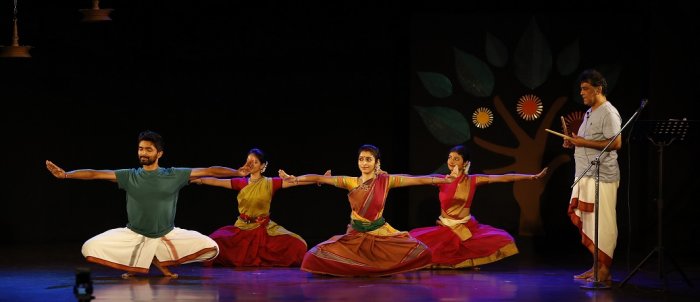 A.Lakshman 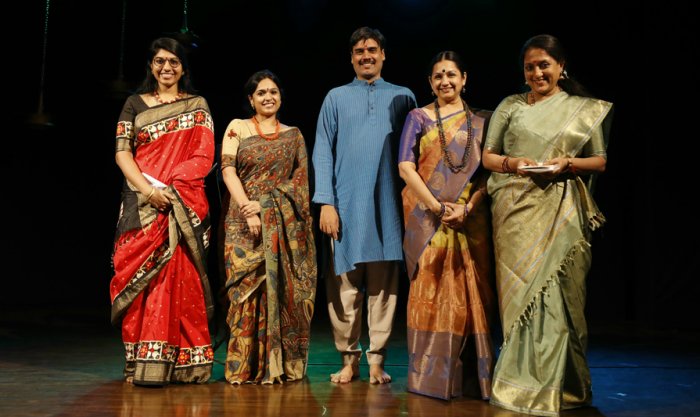 Viewpoint: Manasvini, Aishwarya Ananth, Vijay Madhavan, Roja Kannan, Priya Murle 'Viewpoint' came next. Roja Kannan spoke from the perspective of being a performer, guru and President of ABHAI. "Patience and perseverance are the key. The mantra is to be clear in mind, have a clear conscience," she said. She stated that out of her multiple identities, the dancer in her overpowered in existence. She counselled dancers to create their own opportunities and find their own finances. Contrary to general opinion that male dancers face many challenges, Dr. Vijay Madhavan felt that for him, dance was an accepted norm. Bred in the Bhagavatha Mela tradition dominated by male dancers, it was but natural for every male child to ascend the stage as Prahalada. He spoke of his Natyagraphy initiative that documents dance encapsulating Bharatanatyam movements. "I dance, because I don't know how not to," declared Aishwarya Ananth Karthik. Talking about the physical and mental challenges that a dancer faces, more so in a conservative family, "all we need is some passive support" to persist as performers. Manasvini Korukkai Ramachandran expressed pride in her dance lineage, "Dance is not a skill, hobby, or profession for me. I picked it up as a language." She justified the need for coexistence of art and science by emphasizing that everything around us must have both utilitarian technique and aesthetic appeal. Melattur Natarajan gave a brief history of Bhagavatamela tradition in the session titled 'Bharatanatyam in Bhagavatamela.' He spoke about the many influences such as tailored costumes, the orchestra position to the right of the dancer, flute replacing harmonium, use of Trikala jathis, etc. and attributed them to the influence of Devadasis. The lecture was followed by video projections and live performance of excerpts from different plays. Sanath Kumar, as Budubudukolavaadu, was fast footed and spirited covering the stage space. 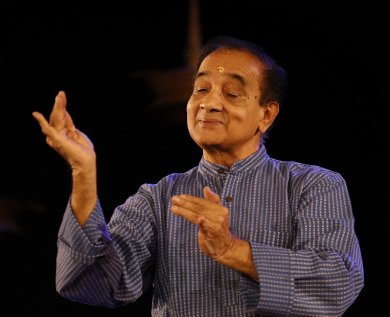 Melattur Natarajan 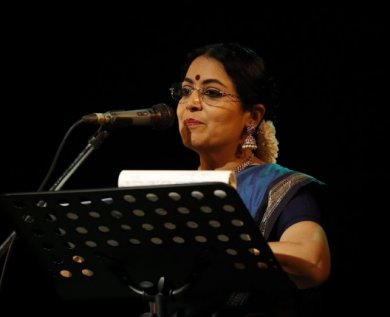 Sreelatha Vinod 'In Praise of,' the nest session by Dr. Sreelatha Vinod elaborated on the historic origins of Kavuthvams and Sabdams. She compared the positioning of Kavuthuvams in the Margam post the Tanjavur Quartette period to its possible origins as per the Nirupanas (the sequence of presentation followed before the current day Margam). Quoting many scholarly works, she highlighted the salient and lost features of Sabdams. "Kuchipudi and Bhagavatamela traditions have kept the nritta aspect of Sabdams intact," she said giving an example of the Manduka Sabdam. Sreelatha also analysed why the complex talas and ragas got filtered out in Sabdams and today they are most commonly in Misra Chapu talam starting in Kamboji ragam. "After exploring Chatusra and Tisra in the opening pieces and Jatiswarams, the Sabdams could have been chosen to be in Misra Chapu as an introduction of the first asymmetric tala," she explained. 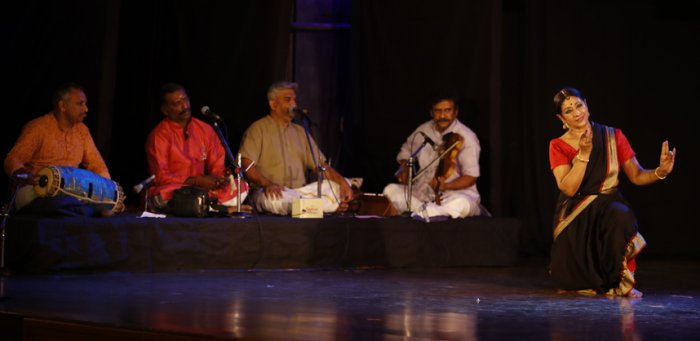 'Varnam: The different hues' by Meenakshi Chitharanjan "The Varnam is the most non-linear abstract piece performed by a Bharatanatyam dancer," opined Meenakshi Chitharanjan. In her presentation focused on decoding aspects of the Tanjavur Quartette varnams, she brought to the fore the importance of Varnams being "simple, having substance and space." Pandanallur Pandian on nattuvangam, Gomathi Nayagam on vocal, Sakthivel Muruganandam on mridangam and R. Kalaiarasan on violin provided a strong and lively support in her presentation of excerpts from the Thodi varnam of Tanjavur Quartette. "After all the new explorations, performing a Tanjore Quartet varnam is sheer bliss of homecoming," she said. 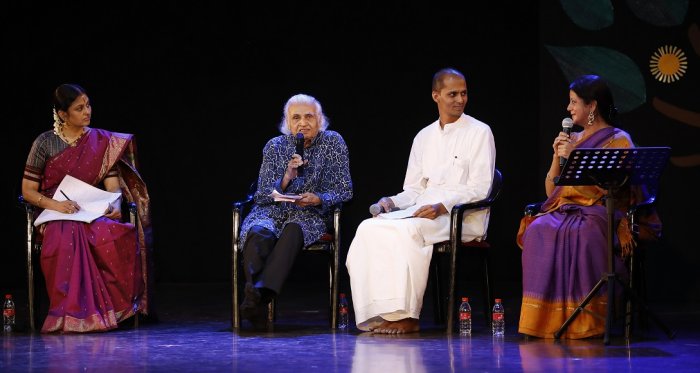 Bhakti as Rasa panel: Pavithra Srinivasan, Dr. Sunil Kothari, S. Jayachandran and Suman Badami The final discussion for the day was very informative and scholarly, addressing an important topic of 'Bhakti as Rasa.' The panel consisted of eminent artistes and researchers Dr. Suman Badami, S. Jayachandran and Pavithra Srinivasan, moderated by Dr. Sunil Kothari. "The Natya Shastra is over-coded with religion," Dr. Suman asserted. She beautifully compared the Vedic and Bhakti period literatures. Analysing the various texts and research papers on Natya Shastra, Rasananda, and Abhinavabharati, she compared the different approaches to Bhakti and the concept of "the universal one." She attributed the different perspectives to Bhakti to its social construct. Quoting sage Narada, Pavithra Srinivasan clearly explained the concept of Bhakti as the combination of Prema (Kama - personal likes and dislikes and Thyaga - acceptance) and Sharanagati (surrender). She further detailed on the classifications of a devotee into the four categories of Arta, Artharti, Jigyasu and Jnani. Her viewpoint on the concept of Parabhakti was well supported with textual references. Establishing that there are "reached and unreached stages of Bhakti," S. Jayachandran explored the concept Bhakti as a constructed institution. "Just like man, family, society and commune, Bhakti is a result of Sankriti (culture), not Prakriti (nature)," he said. In his usual well researched approach, he advised that dancers should be like the vessel that contains Bhakti and not absorb it. He backed up his claim that Bhakti gives you the right to question by comparing the states of Sambhoga and Vipralamba. "Bhakti is not renunciation of action, but renunciation in action," he summed up. Dr. Sunil Kothari was skillful and effective in moderating the panel that was crisp, concise, analytical, scholarly and soulful in its presentation. The plethora of presentations, the dedication of the artistes and the efforts of the convener Priya Murle deserved a much larger audience despite its long-drawn duration that is expected in the very nature of scholarly conferences. Sukanya Kumar is a practitioner of Bharatanatyam and Kathak genres trained under illustrious gurus. She is a Creative Culturist, and choreographer skilled in implementing electronic media technology in her productions to propagate social messages. She has a BSc in electronic media, MFA in Bharatanatyam, MBA in Educational management and MFA in Dance and Technology. |